Immigrants from Cabo Verde Social Profile
COMPARE
Immigrants from Cabo Verde
Select to Compare
Social Profile
Immigrants from Cabo Verde Social Profile
1,391
SOCIAL INDEX
11.5/ 100
SOCIAL RATING
312th/ 347
SOCIAL RANK
Immigrants from Cabo Verde Geographic Distribution
Immigrants from Cabo Verde Income
In terms of income, Immigrants from Cabo Verde residing in the United States exhibit better wage/income gap percentage (23.6%), median female earnings ($38,208), and median earnings ($43,963), but there is room for improvement in household income with householder over the age of 65 ($46,654), household income with householder between the ages 45 and 64 ($83,542), and median family income ($87,830).
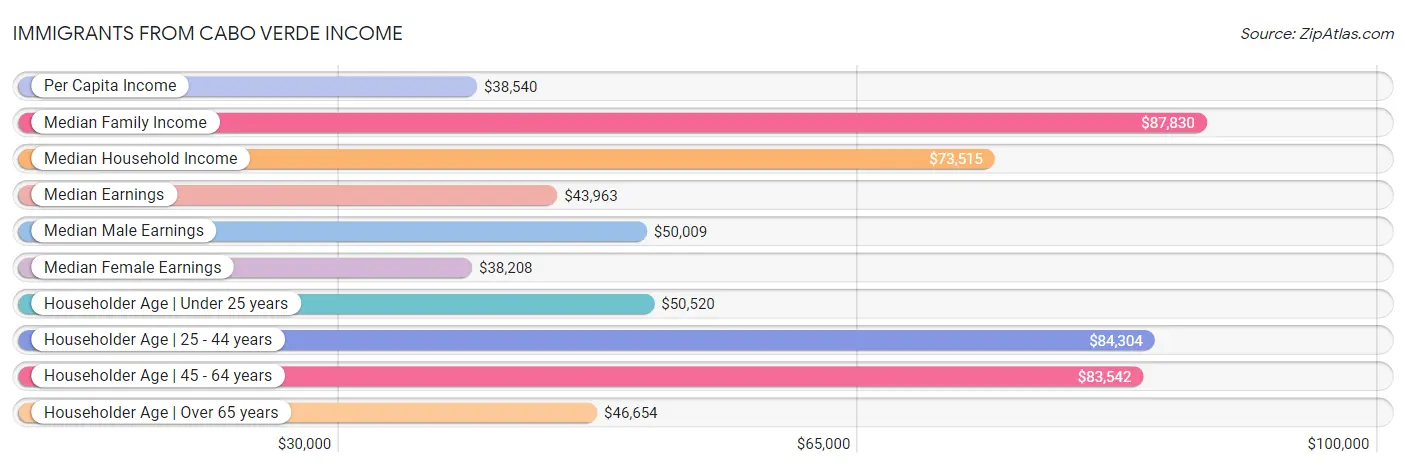
| Income Metric | Rating | Rank | Value |
| Per Capita Income | 0.3 /100 | #272 | Tragic $38,540 |
| Median Family Income | 0.1 /100 | #291 | Tragic $87,830 |
| Median Household Income | 0.1 /100 | #293 | Tragic $73,515 |
| Median Earnings | 3.0 /100 | #247 | Tragic $43,963 |
| Median Male Earnings | 1.2 /100 | #252 | Tragic $50,009 |
| Median Female Earnings | 4.3 /100 | #237 | Tragic $38,208 |
| Householder Age | Under 25 years | 1.7 /100 | #250 | Tragic $50,520 |
| Householder Age | 25 - 44 years | 0.3 /100 | #266 | Tragic $84,304 |
| Householder Age | 45 - 64 years | 0.0 /100 | #308 | Tragic $83,542 |
| Householder Age | Over 65 years | 0.0 /100 | #342 | Tragic $46,654 |
| Wage/Income Gap | 99.5 /100 | #93 | Exceptional 23.6% |
Immigrants from Cabo Verde Poverty
In terms of poverty, Immigrants from Cabo Verde residing in the United States exhibit better poverty level among females between the ages 18 and 24 (19.0%), poverty level among married-couple families (5.3%), and poverty level among single fathers (17.0%), but there is room for improvement in poverty level among seniors over the age of 75 (18.5%), percentage of population receiving government assistance and/or food stamps (23.8%), and poverty level among seniors over the age of 65 (16.2%).
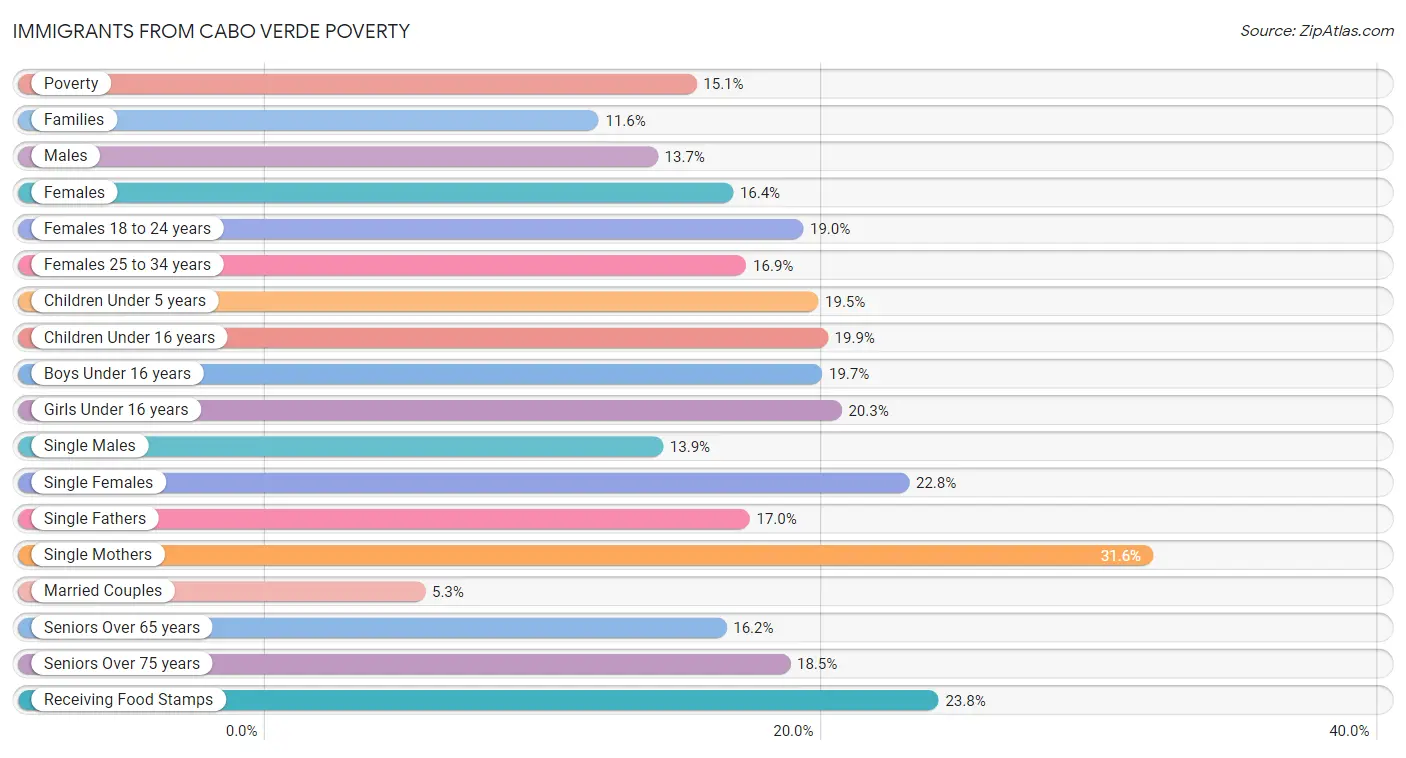
| Poverty Metric | Rating | Rank | Value |
| Poverty | 0.0 /100 | #291 | Tragic 15.1% |
| Families | 0.0 /100 | #293 | Tragic 11.6% |
| Males | 0.0 /100 | #282 | Tragic 13.7% |
| Females | 0.0 /100 | #294 | Tragic 16.4% |
| Females 18 to 24 years | 99.0 /100 | #89 | Exceptional 19.0% |
| Females 25 to 34 years | 0.0 /100 | #305 | Tragic 16.9% |
| Children Under 5 years | 0.6 /100 | #237 | Tragic 19.5% |
| Children Under 16 years | 0.1 /100 | #274 | Tragic 19.9% |
| Boys Under 16 years | 0.1 /100 | #269 | Tragic 19.7% |
| Girls Under 16 years | 0.0 /100 | #285 | Tragic 20.3% |
| Single Males | 0.1 /100 | #266 | Tragic 13.9% |
| Single Females | 0.4 /100 | #261 | Tragic 22.8% |
| Single Fathers | 1.6 /100 | #243 | Tragic 17.0% |
| Single Mothers | 0.1 /100 | #271 | Tragic 31.6% |
| Married Couples | 30.9 /100 | #191 | Fair 5.3% |
| Seniors Over 65 years | 0.0 /100 | #336 | Tragic 16.2% |
| Seniors Over 75 years | 0.0 /100 | #338 | Tragic 18.5% |
| Receiving Food Stamps | 0.0 /100 | #345 | Tragic 23.8% |
Immigrants from Cabo Verde Unemployment
In terms of unemployment, Immigrants from Cabo Verde residing in the United States exhibit better unemployment rate among women with children under the age of 6 (5.4%), unemployment rate among population between the ages 60 and 64 (4.4%), and unemployment rate among population between the ages 65 and 74 (5.3%), but there is room for improvement in unemployment rate among males (7.5%), unemployment rate among population between the ages 35 and 44 (6.9%), and unemployment rate among population between the ages 45 and 54 (5.9%).
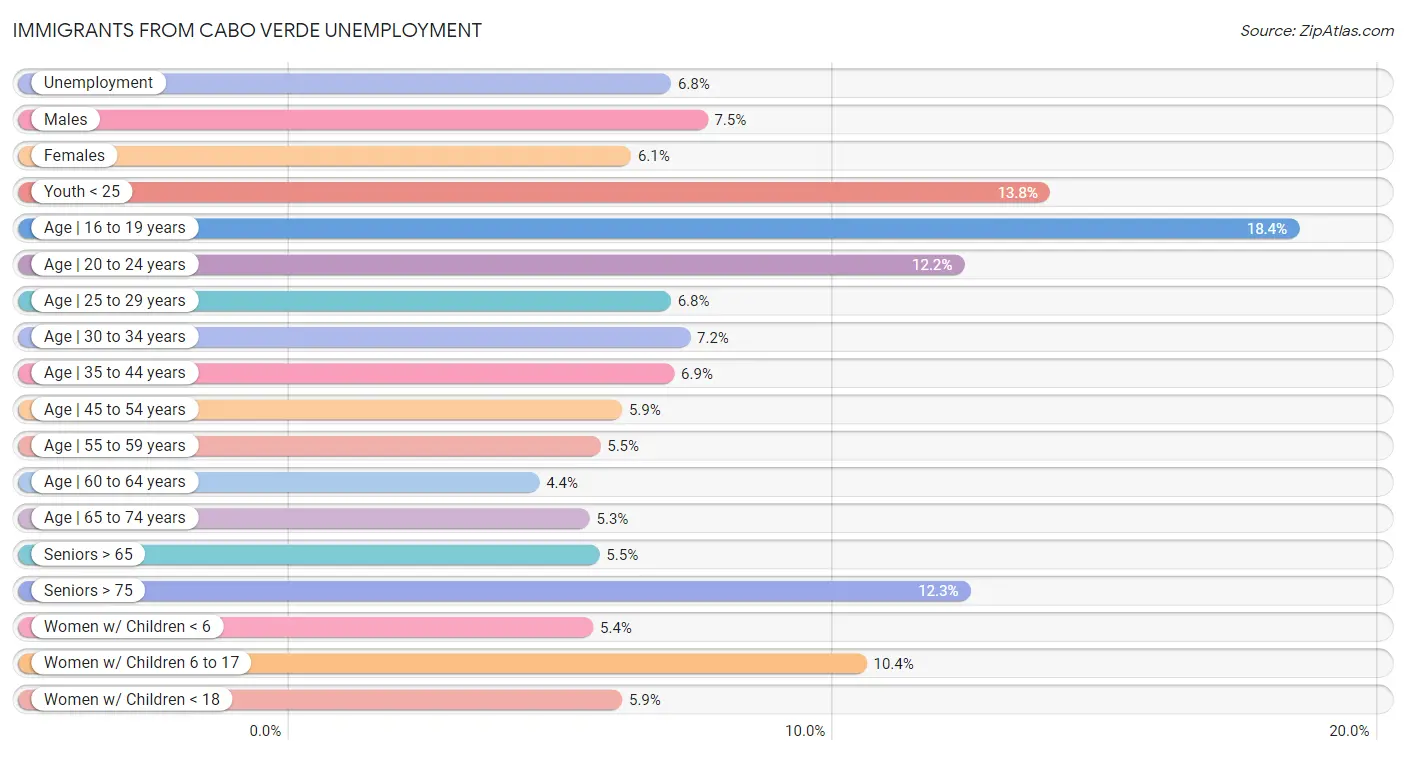
| Unemployment Metric | Rating | Rank | Value |
| Unemployment | 0.0 /100 | #318 | Tragic 6.8% |
| Males | 0.0 /100 | #322 | Tragic 7.5% |
| Females | 0.0 /100 | #285 | Tragic 6.1% |
| Youth < 25 | 0.0 /100 | #300 | Tragic 13.8% |
| Age | 16 to 19 years | 2.0 /100 | #240 | Tragic 18.4% |
| Age | 20 to 24 years | 0.0 /100 | #302 | Tragic 12.2% |
| Age | 25 to 29 years | 16.2 /100 | #212 | Poor 6.8% |
| Age | 30 to 34 years | 0.0 /100 | #317 | Tragic 7.2% |
| Age | 35 to 44 years | 0.0 /100 | #330 | Tragic 6.9% |
| Age | 45 to 54 years | 0.0 /100 | #323 | Tragic 5.9% |
| Age | 55 to 59 years | 0.0 /100 | #306 | Tragic 5.5% |
| Age | 60 to 64 years | 100.0 /100 | #21 | Exceptional 4.4% |
| Age | 65 to 74 years | 72.5 /100 | #153 | Good 5.3% |
| Seniors > 65 | 0.0 /100 | #289 | Tragic 5.5% |
| Seniors > 75 | 0.0 /100 | #338 | Tragic 12.3% |
| Women w/ Children < 6 | 100.0 /100 | #1 | Exceptional 5.4% |
| Women w/ Children 6 to 17 | 0.0 /100 | #314 | Tragic 10.4% |
| Women w/ Children < 18 | 0.7 /100 | #250 | Tragic 5.9% |
Immigrants from Cabo Verde Labor Participation
In terms of labor participation, Immigrants from Cabo Verde residing in the United States exhibit better labor force participation rate among population between the ages 16 and 19 (44.7%), labor force participation rate among population between the ages 20 and 24 (78.9%), and labor force participation rate among population between the ages 35 and 44 (86.2%), but there is room for improvement in labor force participation rate among population between the ages 45 and 54 (82.3%), labor force participation rate among population between the ages 20 and 64 (80.3%), and labor force participation rate among population between the ages 30 and 34 (86.1%).

| Labor Participation Metric | Rating | Rank | Value |
| In Labor Force | Age > 16 | 100.0 /100 | #26 | Exceptional 67.3% |
| In Labor Force | Age 20-64 | 99.0 /100 | #55 | Exceptional 80.3% |
| In Labor Force | Age 16-19 | 100.0 /100 | #8 | Exceptional 44.7% |
| In Labor Force | Age 20-24 | 100.0 /100 | #8 | Exceptional 78.9% |
| In Labor Force | Age 25-29 | 100.0 /100 | #8 | Exceptional 86.2% |
| In Labor Force | Age 30-34 | 100.0 /100 | #14 | Exceptional 86.1% |
| In Labor Force | Age 35-44 | 100.0 /100 | #4 | Exceptional 86.2% |
| In Labor Force | Age 45-54 | 8.6 /100 | #207 | Tragic 82.3% |
Immigrants from Cabo Verde Family Structure
In terms of family structure, Immigrants from Cabo Verde residing in the United States exhibit better percentage of family households with children (27.6%), average family size (3.20), and percentage of population currently divorced or separated (13.1%), but there is room for improvement in percentage of married-couple family households (36.2%), percentage of population currently married (37.8%), and percentage of single mother households (9.6%).

| Family Structure Metric | Rating | Rank | Value |
| Family Households | 0.0 /100 | #314 | Tragic 61.9% |
| Family Households with Children | 75.6 /100 | #153 | Good 27.6% |
| Married-couple Households | 0.0 /100 | #346 | Tragic 36.2% |
| Average Family Size | 16.0 /100 | #206 | Poor 3.20 |
| Single Father Households | 0.0 /100 | #328 | Tragic 3.1% |
| Single Mother Households | 0.0 /100 | #345 | Tragic 9.6% |
| Currently Married | 0.0 /100 | #344 | Tragic 37.8% |
| Divorced or Separated | 0.0 /100 | #300 | Tragic 13.1% |
| Births to Unmarried Women | 0.0 /100 | #328 | Tragic 42.2% |
Immigrants from Cabo Verde Vehicle Availability
In terms of vehicle availability, Immigrants from Cabo Verde residing in the United States exhibit better percentage of households with 4 or more vehicles available (3.8%), percentage of households with 3 or more vehicles available (13.6%), and percentage of households with 2 or more vehicles available (43.3%), but there is room for improvement in percentage of households with 1 or more vehicles available (81.6%), percentage of households with no vehicle available (18.4%), and percentage of households with 2 or more vehicles available (43.3%).

| Vehicle Availability Metric | Rating | Rank | Value |
| No Vehicles Available | 0.0 /100 | #322 | Tragic 18.4% |
| 1+ Vehicles Available | 0.0 /100 | #322 | Tragic 81.6% |
| 2+ Vehicles Available | 0.0 /100 | #324 | Tragic 43.3% |
| 3+ Vehicles Available | 0.0 /100 | #333 | Tragic 13.6% |
| 4+ Vehicles Available | 0.0 /100 | #338 | Tragic 3.8% |
Immigrants from Cabo Verde Education Level
In terms of education level, Immigrants from Cabo Verde residing in the United States exhibit better percentage of population with at least master's degree education (11.3%), percentage of population with at least doctorate degree education (1.3%), and percentage of population with at least professional degree education (3.1%), but there is room for improvement in percentage of population with at least 5th grade education (94.9%), percentage of population with at least 6th grade education (94.4%), and percentage of population with at least 9th grade education (90.9%).
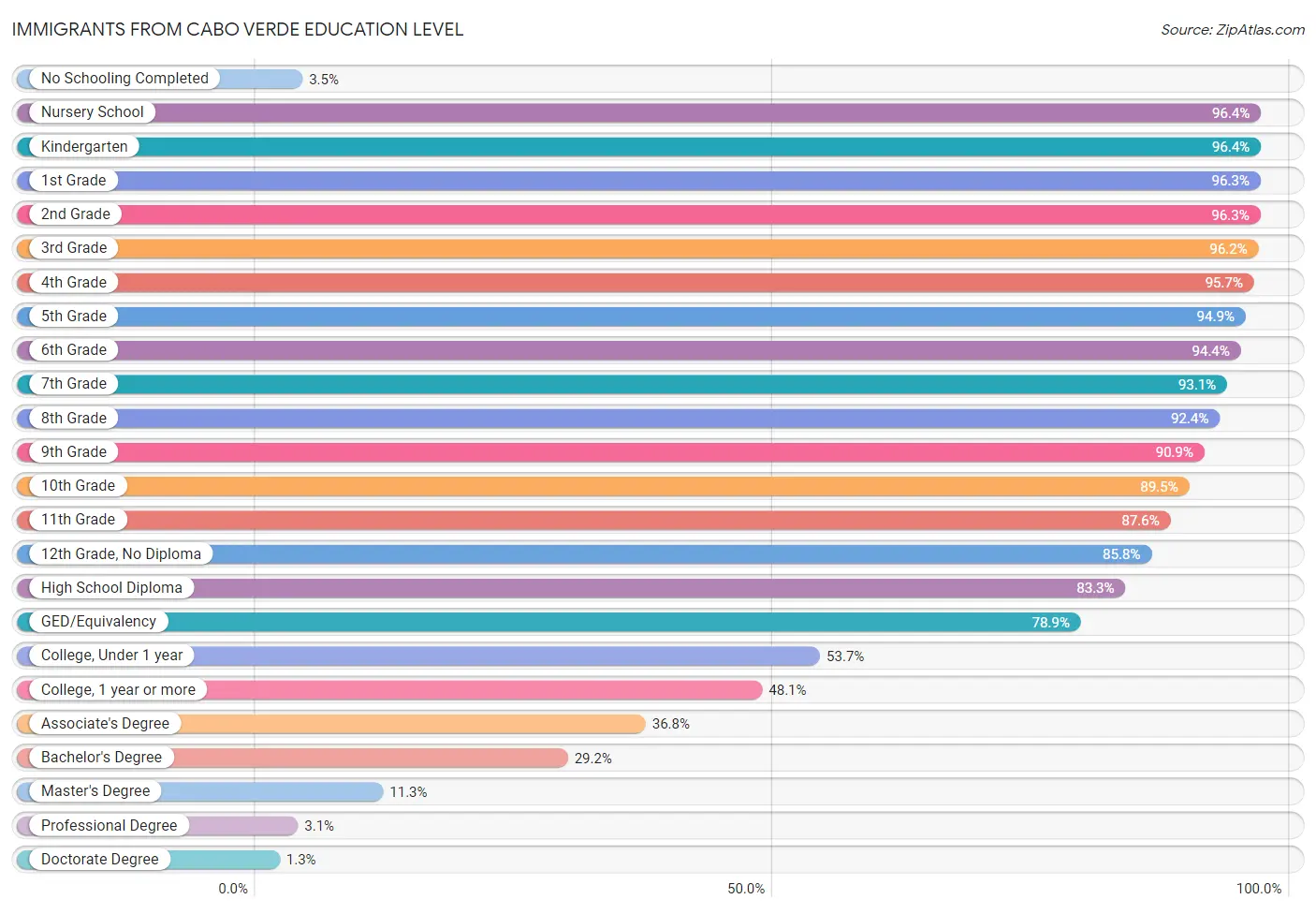
| Education Level Metric | Rating | Rank | Value |
| No Schooling Completed | 0.0 /100 | #337 | Tragic 3.5% |
| Nursery School | 0.0 /100 | #341 | Tragic 96.4% |
| Kindergarten | 0.0 /100 | #341 | Tragic 96.4% |
| 1st Grade | 0.0 /100 | #340 | Tragic 96.3% |
| 2nd Grade | 0.0 /100 | #338 | Tragic 96.3% |
| 3rd Grade | 0.0 /100 | #336 | Tragic 96.2% |
| 4th Grade | 0.0 /100 | #334 | Tragic 95.7% |
| 5th Grade | 0.0 /100 | #338 | Tragic 94.9% |
| 6th Grade | 0.0 /100 | #338 | Tragic 94.4% |
| 7th Grade | 0.0 /100 | #327 | Tragic 93.1% |
| 8th Grade | 0.0 /100 | #329 | Tragic 92.4% |
| 9th Grade | 0.0 /100 | #330 | Tragic 90.9% |
| 10th Grade | 0.0 /100 | #328 | Tragic 89.5% |
| 11th Grade | 0.0 /100 | #327 | Tragic 87.6% |
| 12th Grade, No Diploma | 0.0 /100 | #324 | Tragic 85.8% |
| High School Diploma | 0.0 /100 | #324 | Tragic 83.3% |
| GED/Equivalency | 0.0 /100 | #330 | Tragic 78.9% |
| College, Under 1 year | 0.0 /100 | #341 | Tragic 53.7% |
| College, 1 year or more | 0.0 /100 | #340 | Tragic 48.1% |
| Associate's Degree | 0.0 /100 | #323 | Tragic 36.8% |
| Bachelor's Degree | 0.0 /100 | #315 | Tragic 29.2% |
| Master's Degree | 0.1 /100 | #304 | Tragic 11.3% |
| Professional Degree | 0.0 /100 | #330 | Tragic 3.1% |
| Doctorate Degree | 0.0 /100 | #326 | Tragic 1.3% |
Immigrants from Cabo Verde Disability
In terms of disability, Immigrants from Cabo Verde residing in the United States exhibit better percentage of population with hearing disability (3.0%), percentage of population with a disability between the ages 65 and 75 (26.3%), and percentage of population with a disability between the ages 18 and 35 (7.7%), but there is room for improvement in percentage of population with a disability between the ages 5 and 17 (7.1%), percentage of population with cognitive disability (19.9%), and percentage of females with a disability (14.6%).
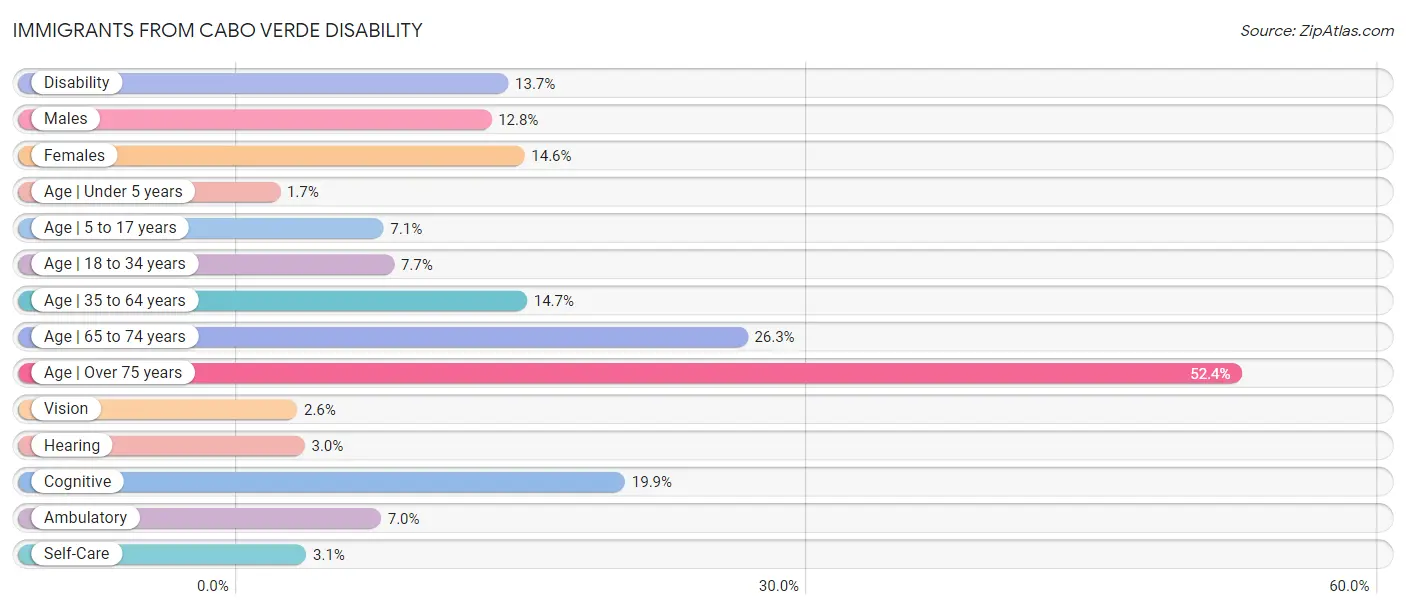
| Disability Metric | Rating | Rank | Value |
| Disability | 0.0 /100 | #317 | Tragic 13.7% |
| Males | 0.0 /100 | #289 | Tragic 12.8% |
| Females | 0.0 /100 | #331 | Tragic 14.6% |
| Age | Under 5 years | 0.0 /100 | #316 | Tragic 1.7% |
| Age | 5 to 17 years | 0.0 /100 | #343 | Tragic 7.1% |
| Age | 18 to 34 years | 0.0 /100 | #294 | Tragic 7.7% |
| Age | 35 to 64 years | 0.0 /100 | #319 | Tragic 14.7% |
| Age | 65 to 74 years | 0.0 /100 | #290 | Tragic 26.3% |
| Age | Over 75 years | 0.0 /100 | #325 | Tragic 52.4% |
| Vision | 0.0 /100 | #303 | Tragic 2.6% |
| Hearing | 56.9 /100 | #170 | Average 3.0% |
| Cognitive | 0.0 /100 | #346 | Tragic 19.9% |
| Ambulatory | 0.0 /100 | #304 | Tragic 7.0% |
| Self-Care | 0.0 /100 | #340 | Tragic 3.1% |
Common Questions
What are the strongest characteristics of Immigrants from Cabo Verde in the United States?
The strongest characteristics of Immigrants from Cabo Verde in the United States are:
#1
Unemployment Rate Among Women with Children Under the Age of 6
5.4%
(100.0/100)
#2
Labor Force Participation Rate Among Population Between the Ages 16 and 19
44.7%
(100.0/100)
#3
Labor Force Participation Rate Among Population Between the Ages 20 and 24
78.9%
(100.0/100)
#4
Labor Force Participation Rate Among Population Between the Ages 35 and 44
86.2%
(100.0/100)
#5
Labor Force Participation Rate Among Population Ages 16 and over
67.3%
(100.0/100)
What are the most vital challenges facing Immigrants from Cabo Verde in the United States?
The most vital challenges facing Immigrants from Cabo Verde in the United States are:
#1
Percentage of Married-couple Family Households
36.2%
(0.0/100)
#2
Percentage of Households with 1 or More Vehicles Available
81.6%
(0.0/100)
#3
Percentage of Population with at least 5th Grade Education
94.9%
(0.0/100)
#4
Percentage of Population with at least 6th Grade Education
94.4%
(0.0/100)
#5
Unemployment Rate Among Population Between the Ages 35 and 44
6.9%
(0.0/100)
What is Immigrants from Cabo Verde per capita income in the United States?
Immigrants from Cabo Verde per capita income in the United States is $38,540, which is tragic, ranking it 272nd out of 347 demographic groups.
What is Immigrants from Cabo Verde median family income in the United States?
Immigrants from Cabo Verde median family income in the United States is $87,830, which is tragic, ranking it 291st out of 347 demographic groups.
What is Immigrants from Cabo Verde median household income in the United States?
Immigrants from Cabo Verde median household income in the United States is $73,515, which is tragic, ranking it 293rd out of 347 demographic groups.
What is Immigrants from Cabo Verde median earnings in the United States?
Immigrants from Cabo Verde median earnings in the United States is $43,963, which is tragic, ranking it 247th out of 347 demographic groups.
What is Immigrants from Cabo Verde median male earnings in the United States?
Immigrants from Cabo Verde median male earnings in the United States is $50,009, which is tragic, ranking it 252nd out of 347 demographic groups.
What is Immigrants from Cabo Verde median female earnings in the United States?
Immigrants from Cabo Verde median female earnings in the United States is $38,208, which is tragic, ranking it 237th out of 347 demographic groups.
What is Immigrants from Cabo Verde wage/income gap percentage in the United States?
Immigrants from Cabo Verde wage/income gap percentage in the United States is 23.6%, which is exceptional, ranking it 93rd out of 347 demographic groups.
What is Immigrants from Cabo Verde poverty level in the United States?
Immigrants from Cabo Verde poverty level in the United States is 15.1%, which is tragic, ranking it 291st out of 347 demographic groups.
What is Immigrants from Cabo Verde poverty level among families in the United States?
Immigrants from Cabo Verde poverty level among families in the United States is 11.6%, which is tragic, ranking it 293rd out of 347 demographic groups.
What is Immigrants from Cabo Verde poverty level among males in the United States?
Immigrants from Cabo Verde poverty level among males in the United States is 13.7%, which is tragic, ranking it 282nd out of 347 demographic groups.
What is Immigrants from Cabo Verde poverty level among females in the United States?
Immigrants from Cabo Verde poverty level among females in the United States is 16.4%, which is tragic, ranking it 294th out of 347 demographic groups.
What is Immigrants from Cabo Verde poverty level among children under the age of 16 in the United States?
Immigrants from Cabo Verde poverty level among children under the age of 16 in the United States is 19.9%, which is tragic, ranking it 274th out of 347 demographic groups.
What is Immigrants from Cabo Verde poverty level among single males in the United States?
Immigrants from Cabo Verde poverty level among single males in the United States is 13.9%, which is tragic, ranking it 266th out of 347 demographic groups.
What is Immigrants from Cabo Verde poverty level among single females in the United States?
Immigrants from Cabo Verde poverty level among single females in the United States is 22.8%, which is tragic, ranking it 261st out of 347 demographic groups.
What is Immigrants from Cabo Verde poverty level among single fathers in the United States?
Immigrants from Cabo Verde poverty level among single fathers in the United States is 17.0%, which is tragic, ranking it 243rd out of 347 demographic groups.
What is Immigrants from Cabo Verde poverty level among single mothers in the United States?
Immigrants from Cabo Verde poverty level among single mothers in the United States is 31.6%, which is tragic, ranking it 271st out of 347 demographic groups.
What is Immigrants from Cabo Verde percentage of population receiving government assistance and/or food stamps in the United States?
Immigrants from Cabo Verde percentage of population receiving government assistance and/or food stamps in the United States is 23.8%, which is tragic, ranking it 345th out of 347 demographic groups.
What is Immigrants from Cabo Verde unemployment in the United States?
Immigrants from Cabo Verde unemployment in the United States is 6.8%, which is tragic, ranking it 318th out of 347 demographic groups.
What is Immigrants from Cabo Verde unemployment rate among males in the United States?
Immigrants from Cabo Verde unemployment rate among males in the United States is 7.5%, which is tragic, ranking it 322nd out of 347 demographic groups.
What is Immigrants from Cabo Verde unemploymnet rate among females in the United States?
Immigrants from Cabo Verde unemploymnet rate among females in the United States is 6.1%, which is tragic, ranking it 285th out of 347 demographic groups.
What is Immigrants from Cabo Verde percentage of family households in the United States?
Immigrants from Cabo Verde percentage of family households in the United States is 61.9%, which is tragic, ranking it 314th out of 347 demographic groups.
What is Immigrants from Cabo Verde percentage of family households with children in the United States?
Immigrants from Cabo Verde percentage of family households with children in the United States is 27.6%, which is good, ranking it 153rd out of 347 demographic groups.
What is Immigrants from Cabo Verde percentage of married-couple family households in the United States?
Immigrants from Cabo Verde percentage of married-couple family households in the United States is 36.2%, which is tragic, ranking it 346th out of 347 demographic groups.
What is Immigrants from Cabo Verde average family size in the United States?
Immigrants from Cabo Verde average family size in the United States is 3.20, which is poor, ranking it 206th out of 347 demographic groups.
What is Immigrants from Cabo Verde percentage of single father households in the United States?
Immigrants from Cabo Verde percentage of single father households in the United States is 3.1%, which is tragic, ranking it 328th out of 347 demographic groups.
What is Immigrants from Cabo Verde percentage of single mother households in the United States?
Immigrants from Cabo Verde percentage of single mother households in the United States is 9.6%, which is tragic, ranking it 345th out of 347 demographic groups.
What is Immigrants from Cabo Verde percentage of population currently married in the United States?
Immigrants from Cabo Verde percentage of population currently married in the United States is 37.8%, which is tragic, ranking it 344th out of 347 demographic groups.
What is Immigrants from Cabo Verde percentage of population currently divorced or separated in the United States?
Immigrants from Cabo Verde percentage of population currently divorced or separated in the United States is 13.1%, which is tragic, ranking it 300th out of 347 demographic groups.
What is Immigrants from Cabo Verde percentage of births to unmarried women in the United States?
Immigrants from Cabo Verde percentage of births to unmarried women in the United States is 42.2%, which is tragic, ranking it 328th out of 347 demographic groups.
What is Immigrants from Cabo Verde percentage of population with a disability in the United States?
Immigrants from Cabo Verde percentage of population with a disability in the United States is 13.7%, which is tragic, ranking it 317th out of 347 demographic groups.
What is Immigrants from Cabo Verde percentage of males with a disability in the United States?
Immigrants from Cabo Verde percentage of males with a disability in the United States is 12.8%, which is tragic, ranking it 289th out of 347 demographic groups.
What is Immigrants from Cabo Verde percentage of females with a disability in the United States?
Immigrants from Cabo Verde percentage of females with a disability in the United States is 14.6%, which is tragic, ranking it 331st out of 347 demographic groups.
Definitions
Social Index (Si) is a quantitative measure of societal well-being and progress based on various factors and indicators.
Social Index Explained
Social Index refers to a cumulative metric used to assess and measure the overall well-being or social standing of a specific demographic group within a society. It combines multiple factors such as income, poverty rates, family structure, education levels, employment and unemployment rates, rates of illegitimate childbirths, divorce rates, and other relevant social indicators. The purpose of a social index is to provide a comprehensive snapshot of the social conditions and quality of life within a particular group.
Social Index Calculation
The calculation of a social index involves assigning weights or scores to various social factors and then summing up these scores to obtain an overall composite score. These scores are then multiplied by their respective weights and summed up to calculate the overall social index score for the demographic group being assessed. The resulting score provides a quantitative measure of the group's social well-being, allowing for comparisons, tracking changes over time, and informing policy and decision-making processes.
What Can Social Index be Used For
A social index can be used for various purposes, including:
- Assessing Social Well-being: The social index provides a quantitative measure of the overall well-being of a demographic group. It helps assess the social conditions, quality of life, and disparities within a population, allowing policymakers, researchers, and organizations to identify areas that require improvement or targeted interventions.
- Policy Evaluation: The index can be used to evaluate the effectiveness of social policies and interventions. By tracking changes in the social index score over time, policymakers can assess the impact of specific initiatives and make data-driven decisions regarding resource allocation and policy adjustments.
- Targeting Resources: The social index helps identify demographic groups or geographic regions that are facing greater social challenges or experiencing lower levels of well-being. It assists in targeting resources and interventions to address specific social issues, reduce disparities, and promote equitable development.
- Comparing Demographic Groups: The social index allows for comparisons between different demographic groups or across different regions. It provides insights into the relative social standing or well-being of these groups, facilitating a deeper understanding of disparities and informing policy efforts to address them.
- Advocacy and Awareness: The social index can be used as a tool for advocacy and raising awareness about social issues. By quantifying and visualizing social conditions, the index helps highlight areas of concern, draw attention to inequalities, and mobilize support for social change and policy reforms.
- Monitoring Progress: The index serves as a benchmark for monitoring progress and evaluating the impact of social development initiatives. It enables stakeholders to track changes in social indicators, identify trends, and measure the effectiveness of interventions over time.
- Academic and Research Purposes: The social index provides researchers with a comprehensive metric to study social phenomena and investigate the relationship between different social factors. It helps generate insights, support academic research, and contribute to the body of knowledge on social well-being and development.
- Overall, the social index serves as a valuable tool for understanding, measuring, and addressing social challenges. It informs policy decisions, facilitates targeted interventions, and promotes a more holistic approach to social development and well-being.